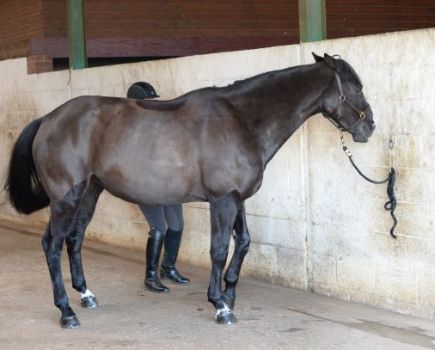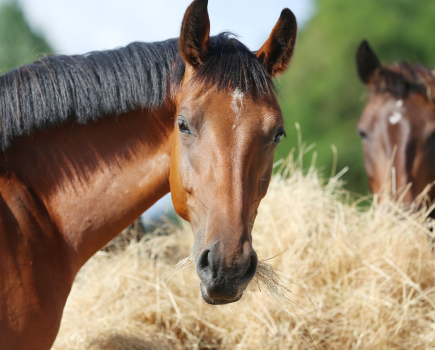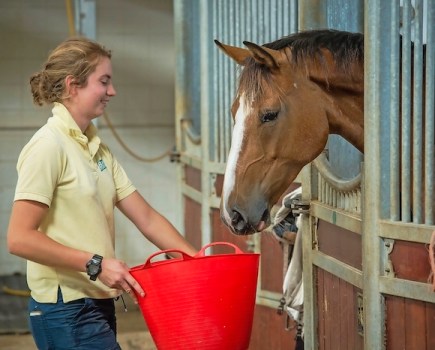With reports of increased colic and laminitis cases due to altered routines after the lockdown, the British Horse Society has released the following advice on how to safely change routines.
You may need to adjust your horse’s management during this challenging time.
Roughing off your horse can be a way of making management a little easier, or if you are having financial difficulties it can be cheaper to put horses out to pasture 24/7.
However this transition needs to be made gradually to ensure the health of your horse is not compromised.
There are also certain situations where roughing off a horse isn’t possible or suitable, for example yard facilities or if your horse needs specialist care and careful management such as those with equine metabolic syndrome, overweight or obese and prone to laminitis.
Assess the environment in which your horse is being kept and where applicable, work with your yard manager to decide on the best management practice to suit everyone’s requirements without compromising the welfare of the horse.
The guidance below will help to make sure your horse is kept as safe and healthy as possible if you’re considering a management change:
Colic
To help reduce the risk of colic it is important to gradually change your horse’s routine and diet over a minimum of 10-14 days.
The horse’s large intestine contains billions of bacteria which are sensitive to change. Introducing new feeds gradually will help the bacteria acclimatise and adapt.
Therefore, it is important to slowly increase the amount of turnout time your horse has and not to suddenly turn out for large amounts of extra time, especially if the horse has been on restricted turnout over winter.
Laminitis
A surge in grass growth can increase the risk of laminitis. Be aware that this can also occur in paddocks recovering from Winter.
Grass is a major contributor of calories in a horse’s diet. Overweight horses or those prone to laminitis are likely to need their grazing restricted.
Grazing can be restricted by using electric fencing to strip graze or setting up a track system.
Sweet Itch
Horses prone to sweet itch can be most commonly affected from March – November when biting flies, such as midges, are most active.
24/7 turnout may not be suitable for horse’s prone to sweet itch as they will be at an increased risk of coming into contact with midges. Stabling horses from dusk to dawn, especially in hot and humid conditions when midges are at their most active, can help prevent horses being bitten.
Sweet itch rugs which cover all the areas of the horse susceptible to bites can provide protection. There are many insect repellents and insecticides on the market but some are more effective than others.
Removing shoes
In consultation with your farrier, arranging for your horse’s shoes to be removed if you aren’t exercising your horse regularly could be a consideration, when your farrier arranges their next visit.
Speak to your farrier for advice on whether this could be a suitable option for your horse. It may be that your horse could cope with their back shoes being removed only, rather than all round removal.
Monitor how your horse is coping and if you have any concerns contact your farrier. Your farrier will also advise on when they should next be due a visit.
Monitoring Weight
Maintaining your horse at a healthy weight can be a real challenge, especially at this time of year, and is a balancing act between providing the right diet, management and exercise.
Your horse may not be getting as much exercise as they’re used to so could be at risk of weight gain.
It will be important to reduce the amount of concentrate feed where necessary, especially if your horse’s workload has significantly decreased.
Remember, as advised above, make changes to feed management gradually.
Research has shown weight gain more than doubles the risk of laminitis. This highlights the importance of regularly monitoring your horse’s weight, especially if they’re going to be spending more time out at grass.
Weightapes are a useful tool to monitor weight changes in your horse as well as taking photos of your horse to help monitor and assess any changes.
Getting hands-on by fat scoring is also helpful to monitor your horse’s body condition. This will enable you to react to changes in your horse’s weight by adjusting their management gradually.
If your horse is fit and well-muscled and is now being exercised less or not at all, you will start to see changes to their body shape due to muscle loss.
Managing grazing
It is important to assess the impact that increased turnout may have on the pasture and horse welfare.
Factors to consider include: the amount of grazing available, any future options to rotate grazing, any additional forage being put out in the field and consideration for parasite control, especially with the change in season.
If poo picking can be carried out, make sure you continue to practise self-distancing from other horse owners and/or staff, and ensure that any shared equipment is thoroughly disinfected after use.
Use of rugs
If your horse wears a rug be mindful that an ill-fitting rug, or one left on for too long without checking, may cause discomfort or even start to rub and cause injury.
Make sure you remove your horse’s rug daily so you can check for signs of rubbing or soreness and then refit or change as necessary.
Check the weather on a daily basis and decide if your horse needs to wear a rug. If your horse’s exercise has been decreased, unnecessary rugging is likely to result in excess fat being stored by the horse rather than being used to keep warm when un-rugged.
Don’t miss the latest issue of Your Horse Magazine, jam-packed with training and veterinary advice, horse-care tips and the latest equestrian products, available now.










